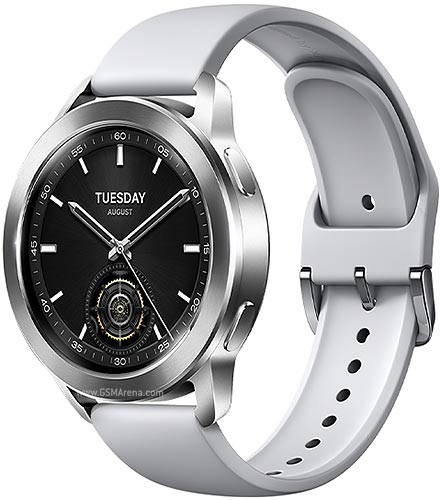Xiaomi’s smartwatch game has steadily evolved since the first Mi Watch came on the scene in 2019. We’ve seen various Xiaomi wearables since – some with simple proprietary operating systems that’s changed more name than features and some with Google’s more capable, but power-hungry WearOS. Xiaomi Watch S3 is the first smartwatch from the brand to launch with HyperOS which is the maker’s in-house operating system that powers numerous other devices including IoT appliances and the maker’s SU7 electric car.

Watch S3 brings everything you’d need in a smartwatch – a bright and crisp AMOLED screen, the standard mix of health and activity tracking, GNSS positioning, NFC payments, and the ability to take calls from your wrist. It’s also highly customizable with interchangeable watch bezels and straps allowing you to adapt the watch to your style.

At €130/£130 in Europe, Xiaomi is positioning Watch S3 as its go-to smartwatch for 2024 and we’ve spent the last two weeks testing it out.
Xiaomi Watch S3 specifications
Display: 1.43″ AMOLED touchscreen, 466 x 466 px resolution, 60Hz refresh rate, 600 nits peak brightness
Straps: Detachable straps, 22mm width, 140-210mm adjustable length
Features: 5ATM rating, Real-time heart rate monitor, 24/7 Blood Oxygen level monitor, Sleep tracking, Stress monitoring, Sports tracking, VO2 Max, Step Counter, Meditation, Notifications, Idle Alert, Phone Finder, Weather Forecast, Music and Camera Control, Recorder, Alarm, Stopwatch, Compass, Barometer, Flashlight
Sports Modes: Outdoor Run, Indoor Run, Outdoor Walk, Outdoor Cycle, Hiking, Strength Training, Jump rope, Freestyle (150+ more in Mi Fitness app)
Sensors: 12-channel PPG optical heart rate sensor, SpO2 sensor, 3-axis accelerometer, barometer, rotor Vibration Motor
Connectivity: Bluetooth 5.2, Compatible with Android 8.0 and iOS 12+, dual-band L1+L5 GNSS, NFC (market dependent), microphone and speakers
Battery: 486 mAh
Colors: Black, Silver
Dimensions: 47 x 47 x 12 mm
Weight: 44 grams without strap
Design
Watch S3 brings a familiar design that falls in line with the Xiaomi Watch 2 generation. It’s a large watch with a 47mm casing and a 1.43-inch AMOLED screen which certainly takes some getting used to if you’re coming from a smaller watch or smartband. The big new addition to the Wach S3 is the stainless steel bezel which is detachable and allows for unparalleled customization options.

A quick counterclockwise twist and turn detaches the bezel and frees up the wach to take in any of the four additional styles which we only presume will grow in number from here. The bayonet mount which is like you’d find on a camera lens is a really neat design choice that locks in securely. Each watch bezel comes with its own watch face which immediately toggles on when it’s attached.
The interchangeable bezels coupled with the endless option of 22mm watch bands enable unprecedented customization, which is a great way to bring new life to the watch down the line. Sadly, the bezel is just for looks and doesn’t add any functionality like you’d get on a Galaxy Watch6 Classic and its rotating bezel. Our silver Watch S3 review unit comes bundled with a matching stainless steel watch bezel and silver fluoro rubber watch strap.

Watch S3 feels as premium as the more expensive smartwatches we’ve tested with its sleek aluminum frame, stainless steel watch bezels, and the plethora of 22mm watch strap options. Despite the large formactor it somehow feels light and unobtrusive on the wrist. Watch S3 weighs 44 grams without the strap and is 12mm thick. It’s also 5ATM waterproof so swimming sessions are a go.
The 1.43-inch AMOLED display offers saturated colors and great viewing angles. It gets bright enough even for outdoor – maxing out at 600 nits of peak brightness and also features a dedicated auto brightness sensor. The display refreshes at 60Hz making it feel snappy and it’s also protected by Gorilla Glass 3. We should note that some of the AOD options are harder to see in direct sunlight.
There are two buttons for navigation with the top one acting as a shortcut to the app menu while also doubling as a back button while the bottom one is programmable and can be paired to launch any app but acts as a shortcut to the workout page by default.

Despite its aluminum alloy frame and stainless steel bezel, Xiaomi Watch S3 weighs 44 grams which does not feel heavy on the wrist and is comfortable to wear all day long. The retail box features the Watch S3, its proprietary two-pin magnetic charging puck which ends in a USB-A cable, and the usual mix of manuals. Wireless charging seems to be the only omission.
Features
Xiaomi Watch S3 packs a long spec sheet with one of its key features being HyperOS. Xiaomi’s proprietary IoT platform looks familiar to MIUI Watch, but sadly does not support third-party apps outside of China.

There are 31 built-in apps including Amazon Alexa, a phone dialer, a voice recorder, an NFC cards app alongside all of the usual set of apps you’d find on a smartwatch like an alarm, a pretty detailed weather app as well as health and activity tracking apps. You also get reminders, calendar, contacts, media controls, breathing exercises, a barometer, compass, flashlight, and a camera shutter.



Xiaomi Watch S3 apps
Watch S3 features a microphone and speaker allowing you to make and take calls from your paired phone over Bluetooth. Our review unit does not feature eSIM connectivity though Chinese versions do, gaining total independence from your phone. Xiaomi is also offering push notifications on the watch for most apps but these are usually just simple alerts without the option to reply or toggle any additional actions.

There are two vibration settings with standard and strong values. In addition to the two physical buttons, Xiaomi added quick gestures which are a gimmicky way to launch additional apps by tilting your wrist 90 degrees or performing a circular motion. Options are limited here with support for summoning Amazon Alexa, the weather app, rejecting incoming calls, and triggering the remote camera shutter function on your paired phone.
Watch S3 also supports dual-band (L1 and L5) satellite positioning over BeiDou, GPS, GLONASS, Galileo, and QZSS as well as NFC payments through Xiaomi Pay. The caveat with payments is that you can only add Mastercard-issued cards and pay at Mastercard payment terminals.
On the health tracking side, Watch S3 features a 12-channel heart rate sensor with 24/7 heart rate monitoring, SpO2 tracking, stress, and sleep tracking with an updated new sleep algorithm offering REM sleep and breathing scores.

Xiaomi’s Mi Fitness app is one mandatory install you’ll need on your paired phone to toggle most of the functions on the Watch S3. The watch supports a total of 161 workout modes covering just about every activity you could think of from running and weightlifting to as nuanced as kite flying and board games.
You get access to the full list of activities within the Workouts app on the watch which is neat and Mi Fitness can keep up to a month’s worth of health and workout data. You can also sync your health and activity data with Apple Health, Google Fit, Strava and Suunto.
There are 13 pre-loaded watch faces with varying levels of customizable elements for watch complications and accent colors. You’ll find a great selection of additional watch faces within the Mi Fitness app too.

Watch S3 also comes with fall detection and emergency assistance functions though they are limited to Android users. These include the ability to call emergency services or an emergency contact of your choosing and send out an SMS message in the event of a fall. You can also store your key medical data on the watch which will be displayed when you trigger the emergency assistance feature. Keep in mind that these settings need to be configured within the Mi Fitness app on your phone beforehand.
Software and performance
While its naming is new, HyperOS did not offer any tangible differences over previous non-Wear OS Xiaomi watches during our testing. The app icons and menus have received a new coat of paint but that’s about it. Xiaomi says that HyperOS will allow for more seamless connectivity and integration between its devices down the line, but for now it’s mostly the same thing under a new name.

While Google’s WearOS offers extensive third-party аpp support and savvier smartphone replacement skills, a watch like the S3 with HyperOS is preferable if you just want to cover the basics of a smartwatch while also getting great battery life. Apart from a dedicated maps app and the option to reply to notifications, I did not feel I was missing any functionality on the Watch S3 during my review period.
The UI is simple and runs without any noticeable lag. You can interact with the watch in a few ways – by double-taping the screen, raising your wrist, or by pushing either of the side buttons. From there you can swipe down for notifications, or swipe up from the bottom to toggle the control center page.
Swiping left or right gives you access to your widgets which are cards of apps bundled together. You can configure up to four apps in a single widget card directly from the watch or within the widgets tab on the Mi Fitness app. Notifications on the Watch S3 come promptly but we already covered the lack of any additional functionality as you can only dismiss them.

The onboard speaker does the job but it’s a bit hard to listen to during calls in noisier environments. The microphone handles voice pickup well with people on the other end of calls reporting loud and clear reception on my part. The watch kept a stable connection to my paired iPhone 15 Pro through the review period with no drops in
Health tracking
Watch S3 supports configurable heart rate tracking via a 12-channel PPG optical heart rate sensor. You can configure the readings between 1 and 30-minute intervals with the shorter values eating up more of your battery life. Heart rate readings were on par with other recently tested smartwatches. You can also set high and low heart rate alerts with alerts appearing once you’ve passed or dropped below a predetermined threshold.

Blood oxygen tracking (SpO2) is also supported with 24/7 readings. In terms of accuracy, we found both the heart rate and SpO2 results offer similar values to what you’d get on competing smartwatches and other health trackers like dedicated pulse oximeters. Don’t expect medical grade readings here as wearables like this are meant for tracking your general well-being. We compared the heart rate and blood oxygen measurements from the watch with those from a specialized heart rate monitor and pulse oximeter and got similar values.





Heart rate, blood oxygen and sleep readings in the Mi Fitness app
Xiaomi is advertising its new sleep analyzing algorithm with claims of improved accuracy and we can confirm it does a great job of logging accurate go-to-sleep and wake-up times. You get a detailed breakdown of your sleep by category with deep, light and rapid eye movement (REM) sleep. Wearing the Watch S3 for a week will generate your own personal sleep insight report with an assigned sleeping animal based on your sleeping pattern as well as a recommended schedule on how to set your day for optimal rest and recovery.

I did experience a bug with a few random additional awake times added to some sleeping sessions even though I was in bed and did not get up at all during those nights. Hopefully, Xiaomi can fix this with future software updates. With the SpO2 tracking feature enabled during sleep tracking you also get breathing scores which can warn you of early signs of sleep apnea.
Activity tracking
Jumping to activity tracking, Xiaomi Watch S3 did not disappoint with accurate step counting and easy-to-read essential workout data. Most workout modes show your basic vitals like heart rate charts, calories burned, workout intensity, VO₂ max, and suggested recovery times. Walking, running and hiking also get some more in-depth metrics like average speed, cadences, stride, and elevation gain. The watch also supports automatic workout detection for a few activities including walking, running, cycling, rowing, jump rope, and elliptical.





Activity tracking metrics in Mi Fitness app
I did encounter a bug where my workout tracking randomly stopped after I unlocked the watch to check through my workout metrics. I found myself missing upwards of 20 minutes during a workout before I noticed the workout was paused without any additional input from my side.

GNSS positioning locks in as instantly when you select any of the supported workouts even if you are indoors which was a surprising feat. Positioning data was fairly accurate on a hiking trail, but not so much during walks in the city as it failed to identify the correct side of the sidewalk from my route.
The dedicated ski mode is a neat addition covering distance traveled, average speed, and a dedicated Ski Track Map which you can share with friends. Sadly Watch S3 does not support the ability to load GPX format maps on the watch for navigating hikes or runs which is something you can do on competitors like Huawei GT4 and Amazfit GTR 4.
Battery Life
Xiaomi Watch S3 features a 486 mAh battery which is claimed to last up to 15 days on a charge with normal usage and 5 days with Always-On Display enabled. Watch S3 provided a decent battery endurance of 4.5 days in my use case. We got these numbers with the AOD toggled on, all of the health tracking features turned on 24/7, a few short phone calls, and a 1:30-hour daily workout. More moderate health tracking and disabling the AOD extends the endurance to 7 days.

The watch is clever enough to give you an estimated battery life based on your usage pattern within the battery menu though we found it to overestimate the values. There’s an ultra power-saving mode that will squeeze out a few extra days of usage but you’ll need to turn off almost all of the features on the watch to achieve those values.
Charging happens exclusively through the two-pin magnetic puck that comes bundled with the watch. It’s backward compatible with the one found on the Xiaomi Watch 2 and Watch S1 series which is good. A 5-minute top-up gets the watch from 0 to 20% while a full charge takes 1 hour. The one major issue however is the lack of any wireless charging which is a big caveat for a smartwatch.
Verdict
Xiaomi Watch S3 brings a mix of premium build and modular design with unparalleled customizability options. The removable watch bezels give the watch a sense of individuality setting it apart from the pack of competitors. You can easily bring new life to the Watch S3 with one of the colorful bezels and the standard 22mm watch bands ensure even more customizability options.

The style-centric approach is backed by accurate health and activity tracking and while it may not offer the capabilities of a proper WearOS watch and all that it entails, it does the basics well enough while offering solid battery life.
The 1.43-inch AMOLED display is crisp and easy to read even outdoors in direct sunlight. The dual-band GNSS positioning connects fast and offers reliable tracking and Bluetooth calling also works great. Xiaomi Pay is somewhat limited by its short list of supported bank cards and sleep-tracking leaves some to be desired.
We also would have liked to see wireless charging for those times when you’re not carrying the proprietary Xiaomi charger and richer notification support with options to reply to incoming messages.

Ultimately, if you want to express your style and have the option to completely transform how your watch looks down the line then the Watch S3 is a great option with no real competition. It’s also bundled with Xiaomi 14 series pre-orders in certain markets which is a great freebie to go with your brand-new phone.
We may get a commission from qualifying sales.
>>> Read full article>>>
Copyright for syndicated content belongs to the linked Source : GSMArena.com – https://www.gsmarena.com/xiaomi_watch_s3_review-news-62055.php































